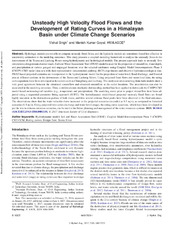| dc.description.abstract | Hydrologic models are not able to compute unsteady flood flows, and the hydraulic models are sometimes found less effective in uncertainty estimation in the modeling outcomes. This study presents a coupled modeling framework to analyze the unsteady flows in the downstream of the Teesta and Lachung Rivers using hydrodynamic and hydrological models. The present approach leads to unsteady flow simulations along stream channel reach. Soil andWater Assessment Tool (SWAT) model is used for the projection of streamflow, water depth, and precipitation at various gauged and ungauged locations over the selected catchment using Coupled Model Intercomparison Phase 5 (CMIP5) CM3 model data sets with their representative concentration pathway (RCP) experiments and observed hydrometeorological data. SWAT-based projected scenarios are incorporated in the hydrodynamic model for the projection of water level, flood discharge, and flooded area at different sections in the downstream of the Teesta and Lachung Rivers. Using projected flood flows and water-level data, the rating curve equations have been developed at the outlets such as Chungthang and Lachung. The study outcomes resulting from both models show a very good agreement between the simulated streamflow and observed streamflow at the outlet locations. The uncertainties can also be associated in the modeling outcomes. Thus, a statistical-cum-stochastic downscaling method has been applied to downscale the CMIP5 CM3 model-based meteorological variables (e.g., temperature and precipitation). The modeling errors prior to project streamflow have been adjusted using a sequential parameter fitting approach (SUFI2). The hydrodynamic model-based projected unsteady flood flows are found highly uncertain in the downstream portion of both rivers, and thus several extreme flood peaks have been observed in the final outcomes. The observations show that the water velocities have increased in the projected scenarios (recorded as 8.5 m/s), as compared to historical scenarios (6.5 m/s). Using projected time series discharge and water level (stage), the rating curve equations, which have been developed as per the low to extreme emission scenarios, can be used in the future planning and management of the water resources systems. | en |


